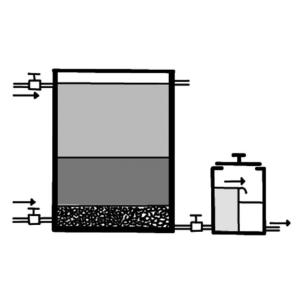Executive Summary
Slow sand filtration is a type of centralised or semi-centralised water purification system. A well-designed and properly maintained slow sand filter (SSF) effectively removes turbidity and pathogenic organisms through various biological, physical and chemical processes in a single treatment step. Only under the prevalence of a significantly high degree of turbidity or algae-contamination, pre-treatment measures (e.g. sedimentation) become necessary. Slow sand filtration systems are characterised by a high reliability and rather low lifecycle costs. Moreover, neither construction nor operation and maintenance require more than basic skills. Hence, slow sand filtration is a promising filtration method for small to medium-sized, rural communities with a fairly good quality of the initial surface water source. As stated by the WHO, slow sand filtration provides a simple but highly effective and considerably cheap tool that can contribute to a sustainable water management system.
| In | Out |
|---|---|
Drinking Water |
Introduction
Slow sand filtration has been an effective water treatment process for preventing the spread of gastrointestinal diseases for over 150 years, having been used first in Great Britain and later in other European countries (LOGSDON 2002). SFFs are still used in London and were relatively common in Western Europe until recently and are still common elsewhere in the world. The move away from slow sand filtration in industrialised countries has largely been a function of rising land prices and labour costs, which increased the cost of SSF produced water. Where this is not the case, SSFs still represent a cost-effective method for water treatment (WHO n.y.). Since these conditions prevail in many developing countries, it is a very promising technique for water purification and, therefore, the development of a sustainable water system.
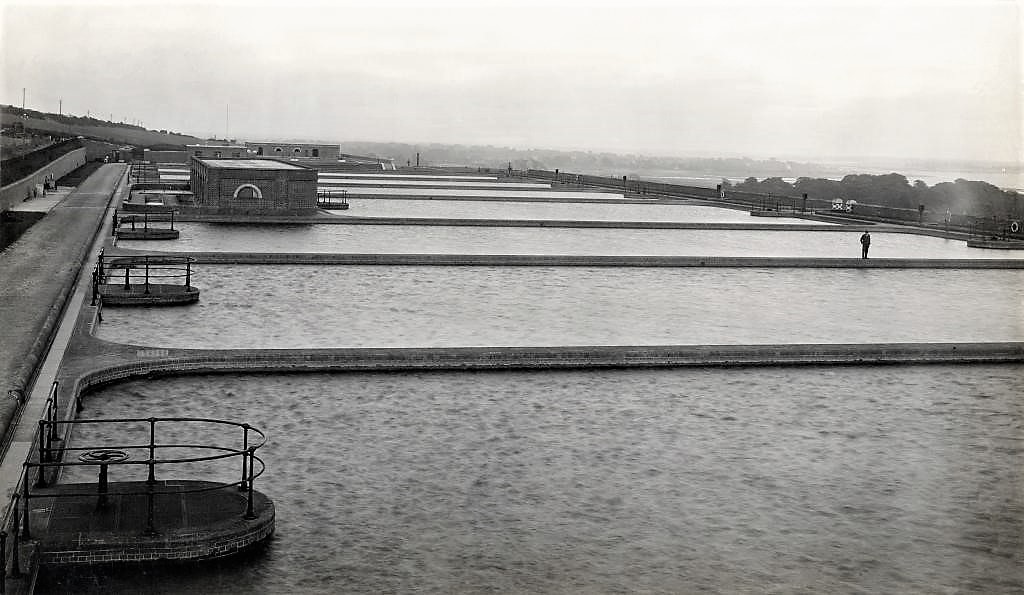
Basic design principles
Process
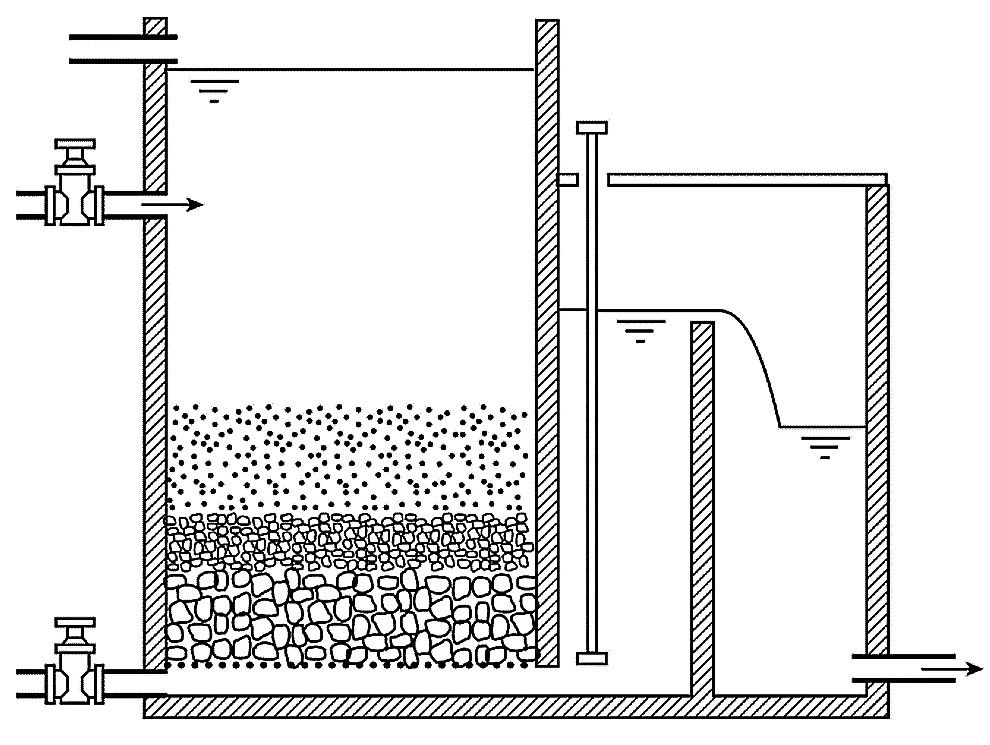
The basic principle of the process is very simple. Contaminated freshwater flows through a layer of sand, where it not only gets physically filtered but biologically treated. Hereby, both sediments and pathogens are removed. This process is based on the ability of organisms to remove pathogens.
In this context, it is important to distinguish slow and rapid sand filtration. The difference between the two is not simply a matter of the filtration speed, but of the underlying concept of the treatment process. Slow sand filtration is essentially a biological process whereas rapid sand filtration is a physical treatment process (WHO n.y.). To learn more about rapid sand filtration have a look at the factsheet: rapid sand filtration.
Although the physical removal of sediments is an important part of the purification process, the relevant aspect is the biological filtration. The top layers of the sand become biologically active by the establishment of a microbial community on the top layer of the sand substrate, also referred to as ‘schmutzdecke’. These microbes usually come from the source water and establish a community within a matter of a few days. The fine sand and slow filtration rate facilitate the establishment of this microbial community. The majority of the community are predatory bacteria that feed on water-borne microbes passing through the filter (WHO n.y.). Hence, the underlying principle of the SSF is equivalent to the bio-sand filtration. While the former is applied to semi-centralised water treatment, the latter mainly serves household purposes.
Structure
As the process itself, the basic structure is very elementary. Essentially, only the filter chamber, a type of reservoir and pipes are required. The filter chamber can either be constructed as an open or as a closed box. Depending on climatic and other factors, the one or the other is more reasonable (e.g. cold climate requires a closed box since low temperatures decrease the performance of the process).
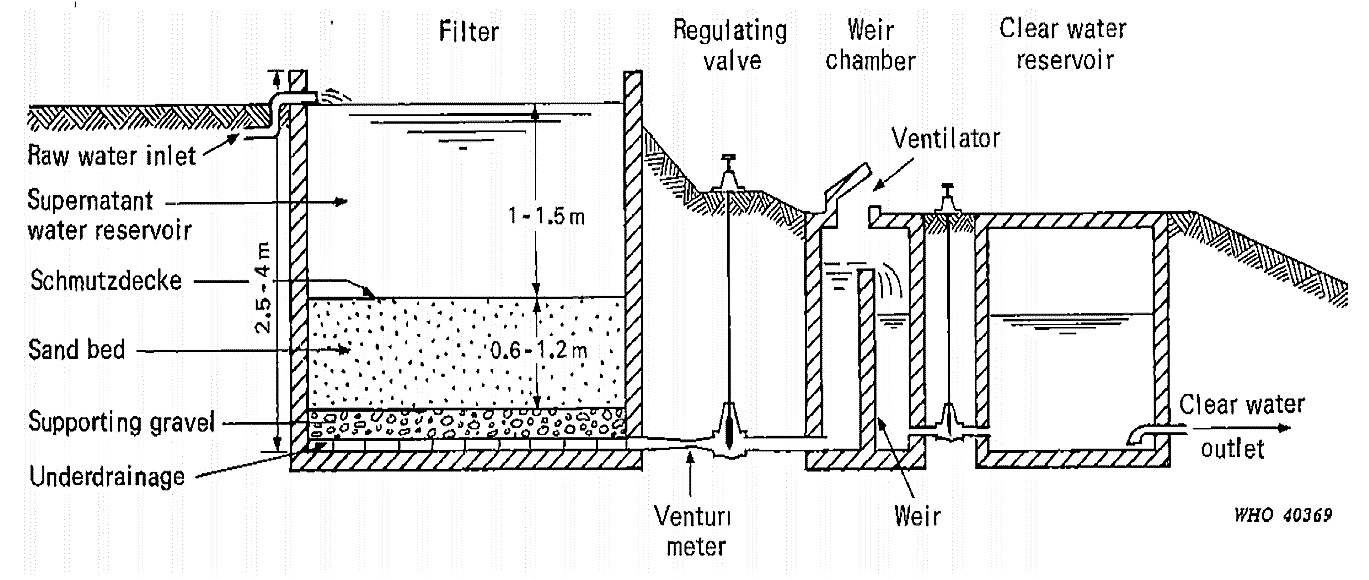
Once a SSF facility is built, only clean sand is required for occasional replacement. The sand layers are put in gradually according to their grain sizes: rather coarse grains at the bottom and fine grains at the top. The sand-bed is usually covered with one meter of supernatant water (LOGSDON 2003). As the process of biological filtration requires a fair amount of time in order to purify the water sufficiently, SSFs usually operate at slow flow rates between 0.1 – 0.3 m3/h per square metre of surface (WHO n.y.). The water thus remains in the space above the medium for several hours and larger particles are allowed to separate and settle (see also sedimentation). It then passes through the sand-bed where it goes through a number of purification processes (HUISMAN 1974).
The water requires some kind of physical pressure in order to pass the drag created by the sand layers. In terms of construction, two different types are feasible. The pressure can be built up either by pumps or gravity. While pump systems need some type of engine and a more elaborate construction, gravity systems work without any highly technological means (HUISMAN 1974).
Health aspects
Slow sand filtration is an extremely efficient method for removing microbial contamination and will usually have no indicator bacteria present at the outlet. SSFs are also effective in removing protozoa and viruses (WHO n.y.). If the effluent turbidity is below 1.0 nephelometric turbidity units (NTU), a 90 to 99% reduction in bacteria and viruses is achieved (NDWC 2000). Yet, slow sand filtration is generally not effective for the majority of chemicals (WHO n.y.). However, it can be argued that chemical standards for drinking water are of secondary concern in water supply subject to severe bacterial contamination (WHO 1996).
| Highly effective for | Somewhat effective for | Not effective for |
| - Bacteria - Protozoa - Viruses - Heavy metals (Zn, Cu, Cd, Pb) | - Odour, Taste - Iron, Manganese - Arsenic | - Salts - Fluoride - Trihalomethane (THM) Precursors - Majority of chemicals |
Typical treatment performance of slow sand filters. Adapted from: BRIKKE & BREDERO (2003), LOGSDON (2002) and WHO (n.y.)
Although SSFs are very effective for the removal of microbiological pathogens, disinfectants (e.g. chlorination) are often used in treatment facilities as a step subsequent to the SSF unit. Firstly for the purpose of inactivating any remaining bacteria as the final unit of treatment, and secondly, for the provision of a residual disinfectant that will remove any bacteria introduced during storage and/or distribution (WHO n.y.). Chlorine is generally added after the filter unit in order to not affect the biological process. If the water contains high amounts of natural organic matter (NOMs), e.g. surface waters in tropical regions, chlorination should be avoided due to the risk of the formation of disinfection by-products (DBPs). When attacked by chlorine radicals, NOMs form trihalomethane (THM) and other organic DBPs, which are known to be carcinogenic.
Reduce the time needed to treat waste water by implementing the rapid sand filtration technology as well or instead. Below, you'll find more information on the slow sand filtration technology.
Construction, operation & maintenance
Construction
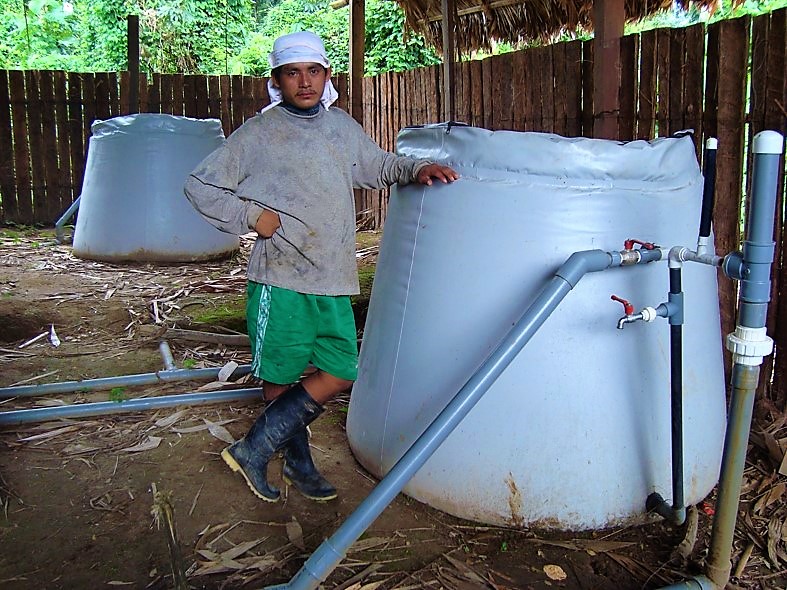
A SSF consists of a box, often made of concrete in which a bed of sand is placed over a layer of gravel and perforated pipes. These pipes collect the treated water (VEENSTRA & VISSCHER 1985).For community use, filter chambers can also be made out of brick or ferro-cement (BRIKKE & BREDERO 2003). Recently, also plastic boxes have been used as filter chambers.
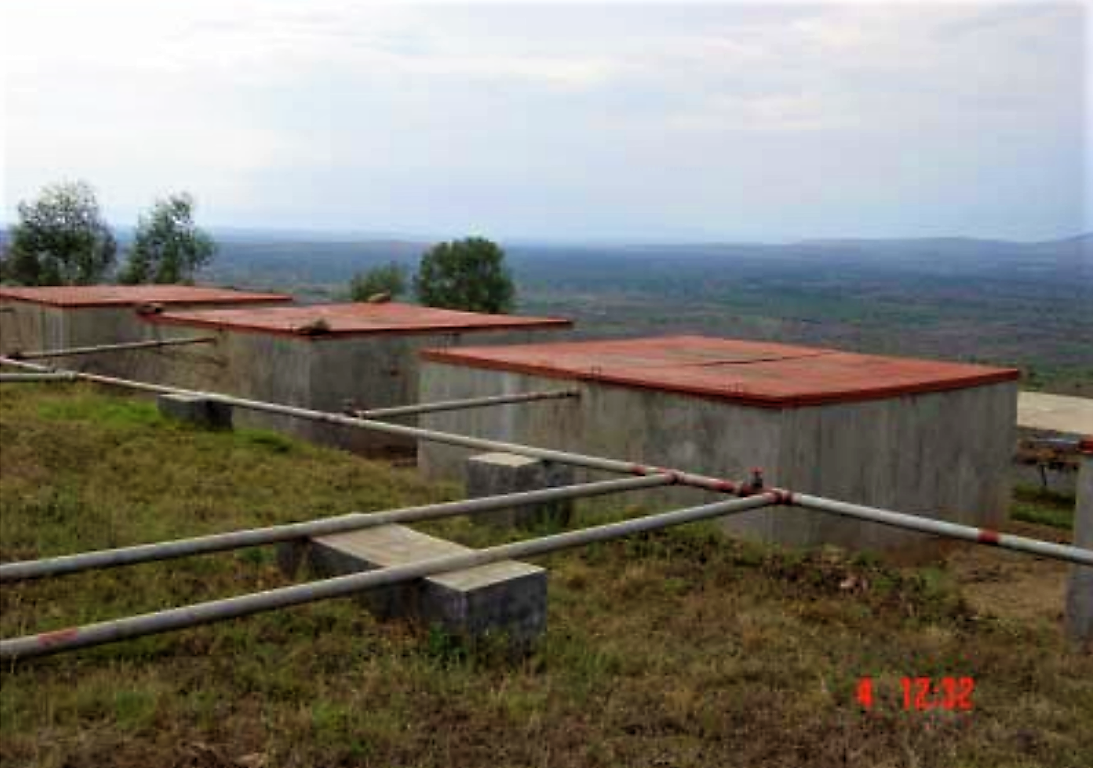
The simple design of SSFs makes it easy to use local materials and skills in their construction (HUISMAN 1974). Due to the simplicity of construction, SSFs can be built by experienced contractors, or by communities with external technical assistance (BRIKKE & BREDERO 2003). Basic hydrological equipment like valves and measurement devices become necessary only if the facility is rather large.
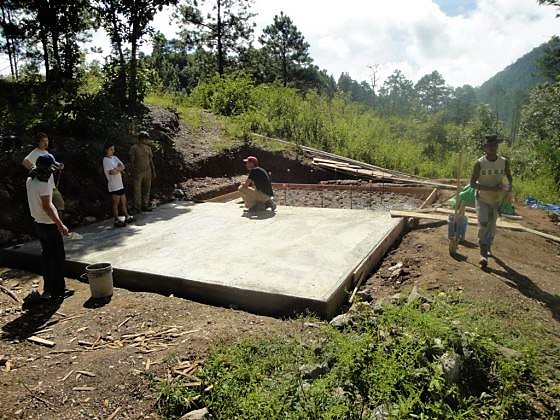
Operation & maintenance
For a SSF to be effective, it must be operated and maintained properly. If topographic circumstances allow the water to flow through gravity during the whole process, no pumps and thus no electricity is required. However, the flow of water must be maintained at a rate between 0.1–0.3 metres per hour. This provides a stable flow of nutrients and oxygen to the microorganisms in the filter and gives them time to treat the water. After several weeks to a few months, the population of microorganisms may get too dense and start to clog the filter. If flow rates are too low, the filter must be drained and the top layer of the sand scraped off, washed, dried in the sun, and stored. After several scrapings, the cleaned and dried sand is added back to the filter, together with new sand, to make up for losses during washing. Every two months, all the valves must be opened and closed to keep them from becoming stuck, and any leaks in the system must be repaired immediately (BRIKKE & BREDERO 2003).
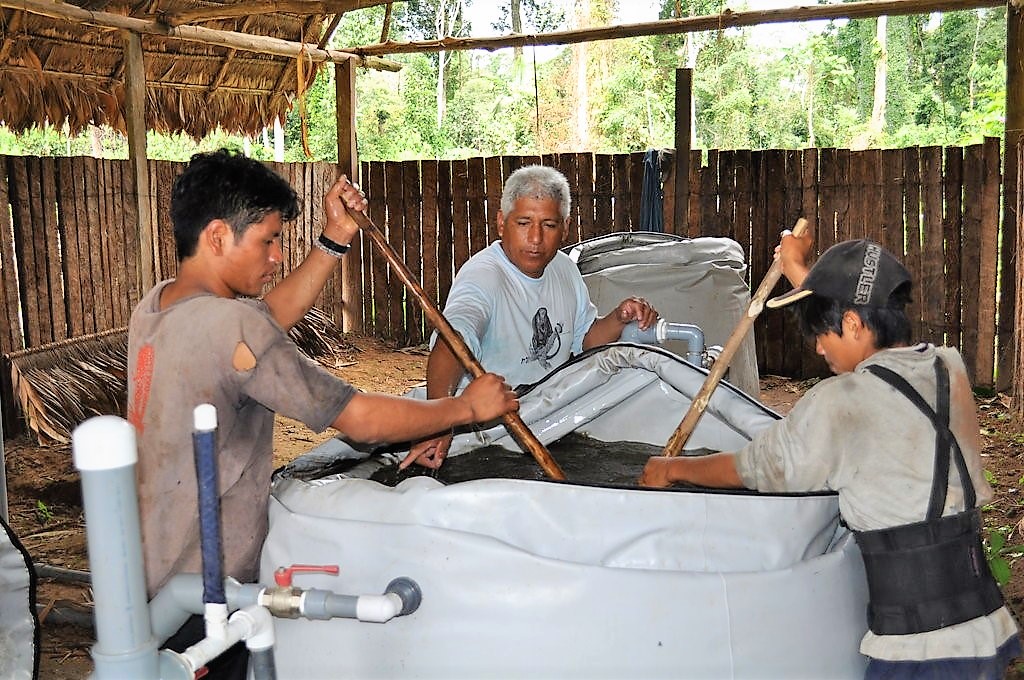
SSFs can be operated and even monitored by communities, provided the caretakers are trained well. It takes a caretaker less than one hour a day to check whether the filter is functioning properly and to adjust flow rates. Several people can clean a filter unit in only one day, but it is important that hygienic measures are observed constantly. If the filter is well-designed and constructed, hardly any repairs of the filter tanks and drainage system will be necessary, although the valves and metal tubing may need occasional attention. If water test kits are available, water quality can be easily monitored without special training. Nevertheless, a SSF for community use requires considerable organisation for scraping and re-sanding the filter units. A local caretaker will have to be trained. Apart from extra sand, some chlorine and test materials, very few external inputs are needed. With proper external assistance, water organisations can manage their water treatment independently (BRIKKE & BREDERO 2003).
Costs
Construction costs
Construction costs strongly depend on local conditions. Since SSFs demand rather large land areas but low input of construction materials, the capital costs primarily consist of wages and costs for land acquisition. The cost of imported materials and equipment may be kept to almost negligible proportions (VEENSTRA & VISSCHER 1985). Therefore, water purification through a SSF is very economical in areas where labour costs are low and land is not a limiting factor.
Operation & maintenance costs
Operational costs are incurred almost solely from the cleaning of the filter beds. No chemicals or other materials are needed for the process. No compressed air, mechanical stirring, or high-pressure water is needed for backwashing. There is thus a saving not only in the provision of plant but also in the cost of fuel or electricity (HUISMAN 1974).
At a glance
| Working principle | Freshwater flows through a sand-bed with a thin layer populated by microorganisms. Hereby, the water gets purified through various biological, physical and chemical processes. |
| Capacity/adequacy | Primarily small, rural communities due to large land requirements (WATER FOR THE WORLD n.y.) |
| Performance | Removes turbidity, protozoa, pathogens, viruses and heavy metals. 100–300 litres per hour per square metre of surface (HUISMAN 1974) |
| Costs | 100–300 USD per square metre (BRIKKE & BREDERO 2003) |
| Self-help compatibility | Very high |
| O&M | Simple, low costs |
| Reliability | Very high if properly operated and maintained |
| Main strength | Simplicity; can be constructed, operated and maintained by the community; often no need for pumps/electricity |
| Main weakness | Large land requirements; excessive turbidity (>30 NTU) in the fresh water can cause the filter to clog rapidly (BRIKKE & BREDERO 2003) |
SSFs require an influent turbidity below 30 NTU and preferably below 10 NTU. Else, pre-treatment measures (e.g. sedimentation) become necessary to ensure that the filters do not become overloaded (WHO n.y.). Moreover, climatic conditions have to be in a moderate range: SSFs are less effective in removing microorganisms from cold water because the biological activity within the filter bed and the ‘schmutzdecke’ declines as temperatures decrease (NDWC 2000). Hence, the adequacy of application is mainly given for the treatment of surface water in small, rural communities where available land is no limiting factor. Alternatively, SSFs may be applicable as a polishing step in wastewater treatment.
Since construction, operation and maintenance are straightforward and do not need more than basic skills, slow sand filtration is a treatment method that is highly self-help compatible and therefore can help to improve water management systems in many regions in developing countries. Although SSFs automatically accommodate minor fluctuations in fresh water quality, temperature, and climatic conditions and are able to cope with short periods of excessive turbidity without breaking down, proper and regular maintenance must be ensured (HUISMAN 1974).
Linking Technology Choice with Operation and Maintenance in the context of community water supply and sanitation. A reference Document for Planners and Project Staff
This document is addressed to planners and staff of water supply and sanitation projects on household and community level. The reader is guided through the main steps of informed choices regarding the main proven technologies for water supply, purification and water treatment at household and community level. Each technology is described in a small factsheet, regarding its functioning, actors and their roles, the main operation and maintenance (O&M) requirements and problems, which can occur.
BRIKKE, F. BREDERO, M. (2003): Linking Technology Choice with Operation and Maintenance in the context of community water supply and sanitation. A reference Document for Planners and Project Staff. Geneva: World Health Organization and IRC Water and Sanitation Centre URL [Accessed: 03.06.2018] PDFConstruction of a Slow Sand Filter
Clean Water and Sanitation – Rainforest in Peru
Slow Sand Filtration
The object of this volume is to discuss the various aspects of one particular form of water treatment - the "biological filtration" or "slow sand filtration" process. This system of water purification has been in continuous use since the beginning of the nineteenth century, and has proved effective under widely differing circumstances.
HUISMAN, L. WOOD, W.E. (1974): Slow Sand Filtration. Geneva: World Health Organisation (WHO) URL [Accessed: 06.02.2012]Slow Sand Filtration for small Water Systems
Slow Sand Filtration. Tech Brief
A short factsheet on slow sand filtration provides information on more technical aspects of slow sand filtration.
NDWC (2000): Slow Sand Filtration. Tech Brief. (= A National Drinking Water Clearinghouse Fact Sheet ). Morgantown: National Drinking Water Clearinghouse (NDWC) URL [Accessed: 06.02.2012]The Slow Sand Filters in Operation (1927)
Slow Sand Filters
A very comprehensive description on how slow sand filters work and how they can be designed. Many examples, and a good reference list at the end of the article.
THAMES WATER ; UNIVERSITY OF SURREY (2005): Slow Sand Filters. [Accessed: 06.02.2012] PDFSlow Sand Filtration: Manual for Caretakers
How can you take care of a slow sand filter on your own? Although slightly out-of-date, this document provides a detailed and well-illustrated description on how to operate and maintain a simple slow sand filter.
VEENSTRA, S. VISSCHER, J.T. (1985): Slow Sand Filtration: Manual for Caretakers. (= IRC Training series , 1 ). The Hague: IRC International Water and Sanitation Centre URL [Accessed: 06.02.3012]Constructing a Slow Sand Filter
Technical solutions for the construction of your own slow sand filters are presented.
WATER FOR THE WORLD (n.y): Constructing a Slow Sand Filter. Vienna: Water for the World. Technical Note, No. RWS. 3.C.3 URL [Accessed: 21.05.2019]Chapter 12: Water Treatment
This document provides an easy to read and yet comprehensive introduction to the water treatment process with slow and rapid sand filters while particularly addressing the multi-barrier principle.
WHO (n.y): Chapter 12: Water Treatment. In: WHO (2009): WHO Seminar Pack for Drinking Water Quality. . URL [Accessed: 07.02.2012]Guidelines for Drinking-Water Quality, Second Edition
This volume of the WHO guidelines for drinking-water quality explains how guideline values for drinking-water contaminants are to be used, defines the criteria used to select the various chemical, physical, microbiological, and radiological contaminants included in the report, describes the approaches used in deriving guideline values, and presents, in the form of brief monographs, critical reviews and evaluations of the effects on human health of the substances or contaminants examined.
WHO (1996): Guidelines for Drinking-Water Quality, Second Edition. (= Health Criteria and Other Supporting Information - Second Edition , 2 ). Geneva: World Health Organization (WHO) URL [Accessed: 31.03.2010]Linking Technology Choice with Operation and Maintenance in the context of community water supply and sanitation. A reference Document for Planners and Project Staff
This document is addressed to planners and staff of water supply and sanitation projects on household and community level. The reader is guided through the main steps of informed choices regarding the main proven technologies for water supply, purification and water treatment at household and community level. Each technology is described in a small factsheet, regarding its functioning, actors and their roles, the main operation and maintenance (O&M) requirements and problems, which can occur.
BRIKKE, F. BREDERO, M. (2003): Linking Technology Choice with Operation and Maintenance in the context of community water supply and sanitation. A reference Document for Planners and Project Staff. Geneva: World Health Organization and IRC Water and Sanitation Centre URL [Accessed: 03.06.2018] PDFSlow Sand Filtration
The object of this volume is to discuss the various aspects of one particular form of water treatment - the "biological filtration" or "slow sand filtration" process. This system of water purification has been in continuous use since the beginning of the nineteenth century, and has proved effective under widely differing circumstances.
HUISMAN, L. WOOD, W.E. (1974): Slow Sand Filtration. Geneva: World Health Organisation (WHO) URL [Accessed: 06.02.2012]Slow Sand Filtration. Tech Brief
A short factsheet on slow sand filtration provides information on more technical aspects of slow sand filtration.
NDWC (2000): Slow Sand Filtration. Tech Brief. (= A National Drinking Water Clearinghouse Fact Sheet ). Morgantown: National Drinking Water Clearinghouse (NDWC) URL [Accessed: 06.02.2012]Slow Sand Filters
A very comprehensive description on how slow sand filters work and how they can be designed. Many examples, and a good reference list at the end of the article.
THAMES WATER ; UNIVERSITY OF SURREY (2005): Slow Sand Filters. [Accessed: 06.02.2012] PDFSlow Sand Filtration for Community Water Supply in Developing Countries. A Design and Construction Manual
This very comprehensive technical paper includes important background information, a detailed description of the principle of slow sand filtration and much information on the construction, design and implementation of slow sand filtration plants.
DIJK, J.C. van OOMEN, J.H.C. (1978): Slow Sand Filtration for Community Water Supply in Developing Countries. A Design and Construction Manual. (= IRC Technical Paper Series , 11 ). The Hague: International Reference Centre for Community Water Supply URL [Accessed: 30.05.2018]Chapter 12: Water Treatment
This document provides an easy to read and yet comprehensive introduction to the water treatment process with slow and rapid sand filters while particularly addressing the multi-barrier principle.
WHO (n.y): Chapter 12: Water Treatment. In: WHO (2009): WHO Seminar Pack for Drinking Water Quality. . URL [Accessed: 07.02.2012]Evaluation of single stage dry slow sand filter in removing some physical pollutants from surface water. Case Study of the Cikapundung River
This case study was conducted in Bandung, India. It was investigated to what extent conventional slow sand filters could be improved through backwashing measures and improved aeration processes.
JOSEPHINNE, M. NOTODARMOJO, S. IRSYAD, M. (n.y): Evaluation of single stage dry slow sand filter in removing some physical pollutants from surface water. Case Study of the Cikapundung River. Bandung: Faculty of Civil and Environmental Engineering ITB URL [Accessed: 21.05.2019]Slow Sand Filtration: Manual for Caretakers
How can you take care of a slow sand filter on your own? Although slightly out-of-date, this document provides a detailed and well-illustrated description on how to operate and maintain a simple slow sand filter.
VEENSTRA, S. VISSCHER, J.T. (1985): Slow Sand Filtration: Manual for Caretakers. (= IRC Training series , 1 ). The Hague: IRC International Water and Sanitation Centre URL [Accessed: 06.02.3012]Constructing a Slow Sand Filter
Technical solutions for the construction of your own slow sand filters are presented.
WATER FOR THE WORLD (n.y): Constructing a Slow Sand Filter. Vienna: Water for the World. Technical Note, No. RWS. 3.C.3 URL [Accessed: 21.05.2019]
